The young sugar maples leafing are more conspicuous now than any maples. Black oak buds are large and silvery. Peach leafed yesterday.
P. M. -- To epigaea.
Salix alba opened yesterday. Gilead not leafing yet, but perhaps to-morrow?
A robin’s nest with two eggs, betrayed by peeping.
On the 30th of April a phoebe flew out from under the arched bridge; probably building.
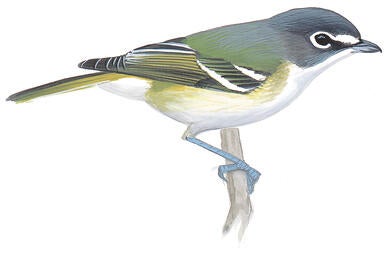 |
| Vireo solitarius |
Equisetum sylvaticum, probably yesterday or day before. Strawberry. That low sedge-like plant under Clamshell very common, with brownish, somewhat umbelled spikes, probably Luzula campestris (?), one of the wood rushes.
Viola lanceolata, yesterday at least. High blackberry has begun to leaf; say two days.
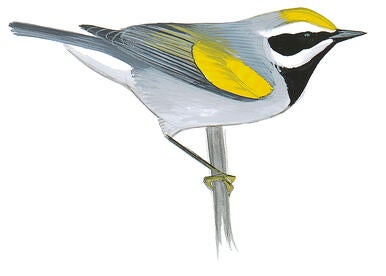 |
| Vermivora chrysoptera (golden-winged warbler) |
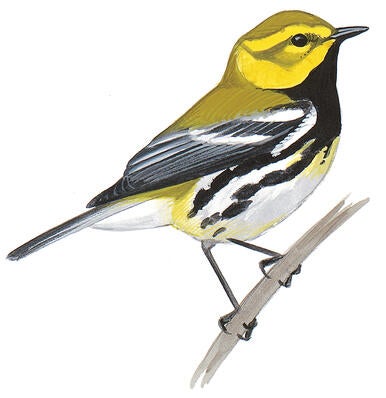 |
| Setophaga virens (black-throated green warbler) |
The small juncus at Second Division shows a field of dark green with reddish top, the flower just beginning to peep out; this the earliest plant of this kind to make a show; more than a foot high.
 |
| Trailing arbutus (epigaea) May 4, 2015 |
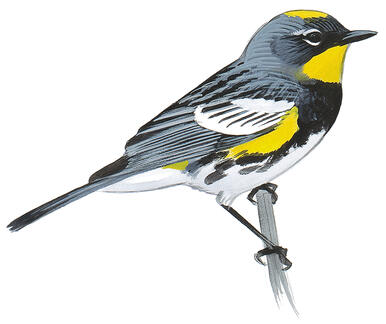 |
| Setophaga coronata (yellow-rumped warbler) |
Many white-throated sparrows there.
Road full of cattle going up country.
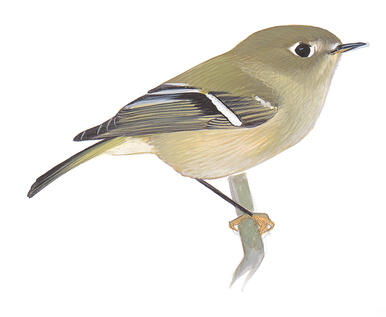 |
| Regulus calendula |
Near Jenny Dugan’s, perceive that unaccountable fugacious fragrance, as of all flowers, bursting forth in air, not near a meadow, which perhaps I first perceived on May 1st. It is the general fragrance of the year. I am almost afraid I shall trace it to some particular plant. It surpasses all particular fragrances. I am not sitting near any flower that I can perceive.
Two or three rods this side of John Hosmer’s pitch pines, beyond Clamshell, some white Viola ovata, some with a faint bluish tinge.
A beautiful sunset, the sun behind a gilt-edged cloud, with a clear bright crimson space beneath.
H. D. Thoreau, Journal, May 6, 1855
The er er twe, ter ter twe, evergreen-forest note. See. May 12, 1854 (" Heard again the evergreen -forest note. It is a slender bird , about size of white-eyed vireo, with a black throat and I think some yellow above, with dark and light beneath , in the tops of pines and oaks. The only warblers at all like it are black-throated green, black-throated blue, black-poll, and golden winged, and maybe orange-crowned");.June 12, 1854 (" Hear the evergreen-forest note , and see the bird on the top of a white pine , somewhat creeper like , along the boughs , and golden head except a black streak from eyes , black throat , slate - colored back , forked tail , white beneath , er te , ter ter te . Another bird with yellow throat near by may have been the other sex . Is it the golden - winged warbler ?"); June 17, 1854 ("The evergreen - forest bird at old place in white pine and oak tops, top of Brister's Hill on right. I think it has black wings with white bars. Is it not the black-throated green warbler") See also May 11, 1854("Hear the evergreen-forest note"); June 1, 1854 ("Hear my evergreen-forest note, sounding rather raspingly as usual, where there are large oaks and pines mingled. It is very difficult to discover now that the leaves are grown, as it frequents the tops of the trees. But I get a glimpse of its black throat and, I think, yellow head "); July 10 1854 ("Evergreen-forest note, I think, still.") and May 30, 1855 ("In the thick of the wood between railroad and Turnpike, hear the evergreen forest note, and see probably the bird,-- black throat, greenish-yellow or yellowish-green head and back, light-slate (?) wings with two white bars. Is it not the black-throated green warbler?”) and A Book of the Seasons, by Henry Thoreau, The Black-throated Green Warbler
That unaccountable fugacious fragrance, as of all flowers, bursting forth in air, . . .the general fragrance of the year. See April 21, 1854 ("As I go up the hill beyond the brook, while the hylodes are heard behind, I perceive the faintest possible flower-like scent as from the earth, reminding me of anemonies and houstonias.”); May 16, 1854 ("The earth is all fragrant as one flower. And bobolinks tinkle in the air. Nature now is perfectly genial to man.”) May 16, 1852 (“The whole earth is fragrant as a bouquet held to your nose. A fine, delicious fragrance, which will come to the senses only when it will.”); June 5, 1853 (“The heavens and the earth are one flower. “).
Dark bill and legs, apparently dark olivaceous ashy head, a little whitish before and behind the full black eyes, ash breast, olive-yellow on primaries, with a white bar, dark tail and ends of wings, white belly and vent. Compare J. J. Audubon (“Bill black, yellow at the base of the lower, and on the edges of the upper mandible. Iris light brown. Feet yellowish-brown, the under parts yellow. The general colour of the upper parts is dull olivaceous ”) See note to April 20, 1859 ("My ruby-crowned or crested wren”)
I think this the only Regulus I have ever seen. See May 7, 1854 ("This was the same I have called golden-crowned . . . except that I saw its ruby crest. I didn't see the crest of the golden-crowned, . . Have I seen the two?); May 11, 1854 (" I am in a little doubt about the wrens . . . whether I have seen more than one. All that makes me doubt is that I saw a ruby, or perhaps it might be called fiery, crest on the last — not golden.”); December 25, 1859 ("I can see a brilliant crown even . . . when I can detect no other part. It is evidently the golden-crested wren, which I have not made out before.”);
Dark bill and legs, apparently dark olivaceous ashy head, a little whitish before and behind the full black eyes, ash breast, olive-yellow on primaries, with a white bar, dark tail and ends of wings, white belly and vent. Compare J. J. Audubon (“Bill black, yellow at the base of the lower, and on the edges of the upper mandible. Iris light brown. Feet yellowish-brown, the under parts yellow. The general colour of the upper parts is dull olivaceous ”) See note to April 20, 1859 ("My ruby-crowned or crested wren”)
I think this the only Regulus I have ever seen. See May 7, 1854 ("This was the same I have called golden-crowned . . . except that I saw its ruby crest. I didn't see the crest of the golden-crowned, . . Have I seen the two?); May 11, 1854 (" I am in a little doubt about the wrens . . . whether I have seen more than one. All that makes me doubt is that I saw a ruby, or perhaps it might be called fiery, crest on the last — not golden.”); December 25, 1859 ("I can see a brilliant crown even . . . when I can detect no other part. It is evidently the golden-crested wren, which I have not made out before.”);




No comments:
Post a Comment